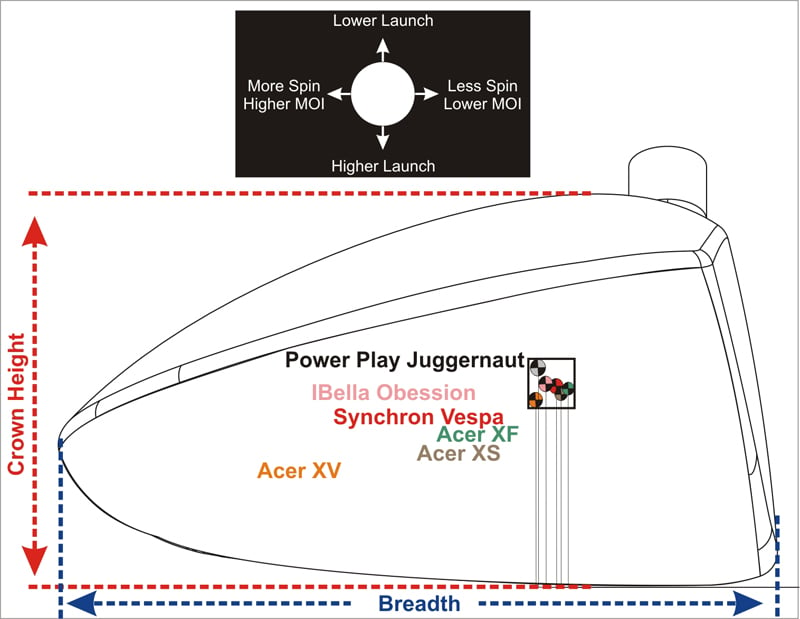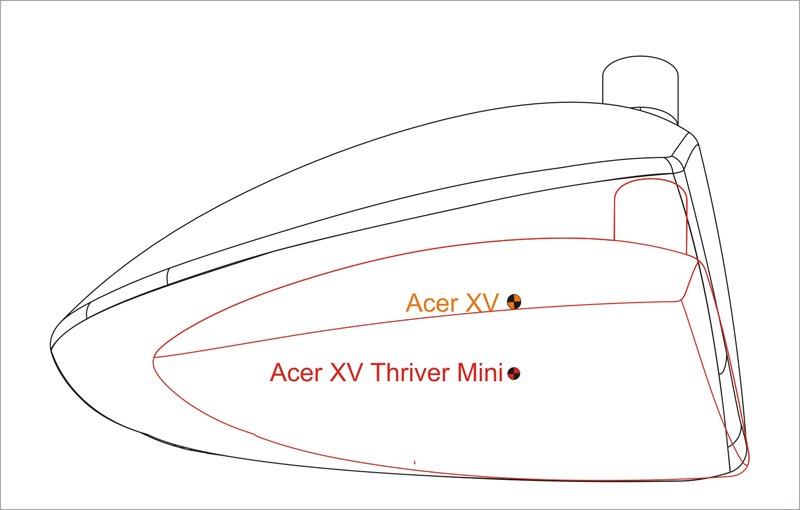Center of Gravity Showdown: Hireko vs OEM Drivers
Hireko Golf’s Technical Director Jeff Summitt Looks at the Differences in Center of Gravity Between Hireko and OEM Drivers and How It Relates To Improving Your Game
If you don’t make the rounds around the Internet looking to increase your equipment knowledge, our friends at MyGolfSpy wrote one of the best technical journalist articles I have seen in a long, long time. It was titled “The Most Popular Drivers of 2015 Secret CG Locations” and helped to dispel a few marketing claims as well as educate readers on some basic laws of physics. Here is that link and you might want to read it first before following below.
 That got me thinking, what if customers asked us about our products – how would they relate to the name brand drivers and what is our philosophy on driver design. To help set the stage, below is an overlay of where the center of gravities will be on our current titanium drivers using one basic driver profile as reference so you can visualize the difference. As you can see, the CGs of each model falls within a small box (like the article mentions) where the differences both vertically and horizontally are two-tenths of an inch (5 millimeters) apart.
That got me thinking, what if customers asked us about our products – how would they relate to the name brand drivers and what is our philosophy on driver design. To help set the stage, below is an overlay of where the center of gravities will be on our current titanium drivers using one basic driver profile as reference so you can visualize the difference. As you can see, the CGs of each model falls within a small box (like the article mentions) where the differences both vertically and horizontally are two-tenths of an inch (5 millimeters) apart.
Let’s help explain these subtle differences between our models. In our catalog we list a few key dimensions; face height and breadth. You may not be familiar with breadth, but it is the distance from the front to the back of the head. Some may say it is the width. While face height can be good indicator of relative height, I personally like to use the actual crown height or the distance from the sole to the uppermost portion of the crown. The following table will summarize our non-offset (draw) models.
| Model | Face Height | Crown Height | Breadth | Launch | Spin |
| (mm) | (mm) | (mm) | |||
| Acer XV | 55 | 63 | 114 | High | Low-Mid |
| Acer XS | 55 | 62 | 115 | Mid-High | Mid |
| Acer XF | 55 | 62 | 114 | Mid | Mid |
| Power Play Juggernaut | 57.5 | 66 | 119 | Mid-Low | Mid |
| iBella Obsession | 54 | 64 | 111 | High | High |
| Synchron Vespa | 57 | 62.5 | 117 | Mid | Mid |

Generally the center of gravity of a head will follow the geometry as we explain in our Modern Guide to Golf Clubfitting book. For instance, if you make the club taller or deeper (like the Power Play Juggernaut) the center of gravity should move up along with it. It is not surprising it has the highest center of gravity among our current models. Another generality is if you make the head broader or wider, the CG should follow. However, that is not always the case though as the face area is important too. The face has to be the thickest portion of the club to withstand the impact with the ball so it is approximately 3 times as thick as the crown and 2.5 times the thickness of the sole. This was the reason why the Synchron Vespa did not have as rearward CG as the breadth would indicate because the face is deep and also wide.
 Now if you are wondering why we don’t have more variety in sizing that actually comes back to what our customers will buy. The majority of you want a 460 cc driver (or at most nominally smaller) that has a traditional shape. Plus you do not want one that is too shallow to hit from a tee nor too deep that will require you to use the super long tees. Basically there is a sweet spot in size and shape we along with the rest of the golf industry follow. The exception would be the new category of mini drivers (small drivers or very large 3 woods) like our Acer XV Titanium Thriver Mini. Here is its’ CG location along with the outline of it compared to the matching driver. The CG in this case is a whopping 12mm or nearly 0.5” lower than the driver partially due to the crown height and our next topic.
Now if you are wondering why we don’t have more variety in sizing that actually comes back to what our customers will buy. The majority of you want a 460 cc driver (or at most nominally smaller) that has a traditional shape. Plus you do not want one that is too shallow to hit from a tee nor too deep that will require you to use the super long tees. Basically there is a sweet spot in size and shape we along with the rest of the golf industry follow. The exception would be the new category of mini drivers (small drivers or very large 3 woods) like our Acer XV Titanium Thriver Mini. Here is its’ CG location along with the outline of it compared to the matching driver. The CG in this case is a whopping 12mm or nearly 0.5” lower than the driver partially due to the crown height and our next topic.
Discretionary weight
One term you may see written in the description of a clubhead is discretionary weight or weight that was saved somewhere and used judiciously in another area. Since most heads are 460cc and weigh @ 200 grams, it is the goal of a club designer to make the walls in certain areas as thin as possible to save weight and yet still have the head hold up to the rigors after repeated impacts. Sometimes that is a fine line.
Some of Hireko’s drivers tout our variable crown technology. This is a fancy way of saying we freed up weight in the crown that we can shift it south and lower the center of gravity. This includes our Acer XV and Acer XS lines. Another example of discretionary weight is the addition of the screw weight (Gravity Port) in the Acer XV series. It is positioned in the aft portion of the sole to both lower and move weight away from the face. It comes at a cost though. To add this as well as the variable crown thickness feature, it makes the head a little more expensive to manufacturer. But in the end you are getting our most forgiving as well as our lowest center of gravity driver.
You might wonder why we didn’t use the variable crown to lower the center of gravity of the ladies iBella Obsession. Well, lowering the CG can also reduce spin due to the vertical gear effect which is exactly the opposite of what a slower swinging player needs. Here we have moved the CG rearward and increased loft to help increase trajectory and spin to sustain increased carry distance for the golfers who are swing speed challenged.
What’s up with the forward CG trend?
Even though the Acer XF has the most forward CG of our group, it is still nowhere considered forward like the recent trend by a few OEMs to help reduce spin. If compared against the name brand drivers in the MyGolfSpy article, it would be in the middle range. So far we have been reluctant to offer any driver with a true forward center of gravity since the majority of our customer base needs as much forgiveness as possible and that is why our design philosophy has been to offer clubs in the low and rearward CG camp. For each millimeter the CG moves forward in a modern 460cc driver, this reduces the Moment of Inertia (MOI) by @ 88 g-cm^2. When the average 460cc driver has a MOI of 4350 g-cm^2, a 4mm forward shift in the CG can reduce the level of forgiveness nearly 10%.
So there you have it. Function follows form or something along those lines unless one can utilize new construction methods or the usage of less dense materials in order to shed a considerable amount of unwanted weight and move it to a specific area of the head to influence ball flight. Remember, those two things usually come in the form of a higher cost. Now I hope you have a better understanding of what to “look” for when you are in the market for a new driver and escape the marketing jargon which will ultimately help you excel on the course.
